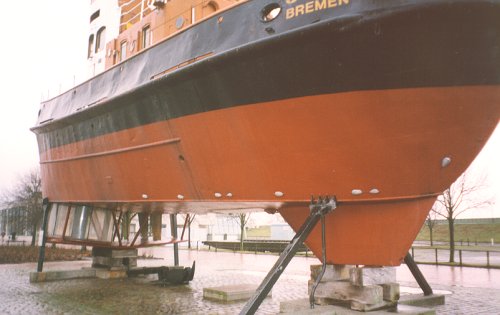| Electrochemical decomposition | [German version] |
Metal surfaces undergo an electrochemical reaction (corrosion) when they come into contact with electrolytes (corrosive agents). Corrosive agents may be atmospheric gases, such as sea, urban and industrial air (e.g. sulfur di- and trioxide, hydrogen chloride and hydrogen sulfide) or liquid corrosives such as salts, bases, acids and seawater or the same dissolved in water (e.g. sweaty hand marks).
When metal and corrosive agent react electrochemically, the metal loses its electrons to the corrosive agent. The metal is abraded, so to speak, i.e. it corrodes. If two different metals are connected via an electrolyte, electrons are exchanged between the metals. This form of corrosion is known as bimetallic corrosion. Fretting corrosion occurs when the surface of a metal is roughened by friction from foreign materials; these metal particles react with the environment. A distinction may be drawn between various Types of corrosion.
The intensity of the corrosion depends on the position of the metal in the electrochemical series, the latter being determined by the level of the negative potential of the metal: the higher is the negative potential, the baser and more susceptible to corrosion is the metal.
Electrochemical series of metals/nonmetals (no distinction has been drawn between the reduced and oxidized forms of the individual materials):
| Material | Potential in volts [Römpp Chemie-Lexikon, www.uni-ulm.de] |
Metal (M) Nonmetal (NM) |
| Lithium (Li) | -3.04 | M |
| Potassium (K) | -2.92 | M |
| Barium (Ba) | -2.90 | M |
| Calcium (Ca) | -2.87 | M |
| Sodium (Na) | -2.71 | M |
| Magnesium (Mg) | -2.36 – -2.37 | M |
| Aluminum (Al) | -1.68 | M |
| Manganese (Mn) | -1.18 – -1.19 | M |
| Zinc (Zn) | -0.76 | M |
| Chromium (Cr) | -0.74 | M |
| Sulfur (S), solid | -0.48 – -0.51 | NM |
| Iron (Fe) | -0.41 – -0.44 | M |
| Cadmium (Cd) | -0.40 | M |
| Thallium (Tl) | -0.34 | M |
| Cobalt (Co) | -0.28 | M |
| Nickel (Ni) | -0.23 | M |
| Tin (Sn) | -0.14 | M |
| Lead (Pb) | -0.13 | M |
| Hydrogen (2H) | 0.00 | |
| Copper (Cu) | +0.15 | M |
| Iodine (I), solid | +0.54 | NM |
| Silver (Ag) | +0.80 | M |
| Mercury (Hg) | +0.85 | M |
| Bromine (Br), liquid | +1.07 | NM |
| Platinum (Pt) | +1.20 | M |
| Chlorine (Cl), gaseous | +1.36 | NM |
| Gold (Au) | +1.50 | M |
| Fluorine (F), gaseous | +2.87 | NM |
Steel hulls of ships, which come into contact with seawater (an electrolyte) and consequently corrode (rust) are directly connected with base metals (e.g. zinc) to provide protection against corrosion. Through the transfer of electrons from the zinc to the iron atoms of the steel, corrosion is inhibited until the zinc has been completely dissolved by the electrochemical reaction. The sacrificed pieces of metal are known as „sacrificial anodes“ (see Figure 1).
 |
| Figure 1: Sacrificial anodes on the hull of a tug. |
Back to beginning
